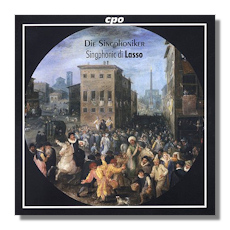
The Internet's Premier Classical Music Source
Related Links
- Lassus Reviews
- Latest Reviews
- More Reviews
-
By Composer
-
Collections
DVD & Blu-ray
Books
Concert Reviews
Articles/Interviews
Software
Audio
Search Amazon
Recommended Links
Site News
 CD Review
CD Review
Orlando di Lasso

German Songs, French Chansons,
and Italian Madrigals & Villanelles
- Lied à 5 "Hort zu ein news Gedicht"
- Lied à 5 "Der Meye bringt uns der Blumlein vil"
- Lied à 5 "Im Mayen hört man die Hanen krayen"
- Lied à 5 "Der Wein, der schmeckt mir also"
- Lied à 5 "Fraw ich bin euch von hertzen Hold"
- Lied à 4 "Ein Esel und das Nussbawmholtz"
- Lied à 5 "So trincken wir alle"
- Chanson à 5 "Un (Mon) triste Cœur rempli"
- Chanson à 4 "Fleur de quinze ans"
- Chanson à 5 "Quand mon mari s'en va dehors"
- Chanson à 4 "La nuict froide et sombre"
- Chanson à 5 "De tout mon Cœur"
- Chanson à 4 "Bon jour mon coeur"
- Chanson à 6 "Dessus le marche d'Arras"
- Chanson à 4 "O vin en vigne" (Bonte divine, vien et monster)
- Madrigal à 5 "Miser qui speme in cose mortal pone"
- Villanelle à 4 "Madonna mia pieta"
- Madrigal à 5 "La vita fugge"
- Villanelle à 4 "S'io fusse ciaul'ettu"
- Madrigal à 5 "La ver e'aurora"
Die Singphoniker
CPO 999855-2 DDD 51:51
Orlando di Lasso (or, perhaps more in keeping with his Walloon origins, Roland de Lassus) is remembered today chiefly for his sacred works. This CD might be subtitled "the lighter side of Lasso" as it contains 20 examples of his popular, or at any rate, secular compositions. In fact, some of these would not be suitable for a more pious audience. In Fleur de quinze ans, the singer offers to teach a 15-year-old girl the "five points of love" – the last, "in my shirt or, even better, in the nude." A "depraved" Spaniard tells a girl in Dessus le marché d'Arras that "they will pay good money for you."
In S'io fusse ciaul' et tu, the singer compares himself to a jackdaw and his love to a bell tower, ending with the image of "at night com[ing] in through your nest hole." There's also a jolly German lied – with words by Hans Sachs! - about the many types of noses in the world, from the hairy to the runny and everything else. Writing for German-, French-, and Italian-speaking listeners, Lasso showed that love, sex, and alcohol were international interests.
Lasso wrote these compositions for four to six voices. It would have been common in the sixteenth century for the higher parts to be sung by boys. The German ensemble Die Singphoniker argues that the "dubious" content of some of these works is a strong point in favor of having only adults perform these works. Die Singphoniker's six members include a full-grown male alto, Alfons Brandl. (The other five members are tenor Christoph Rösel, baritones Ludwig Thomas and Berno Scharpf, bass-baritone Gunnar Mühling, and bass Christian Schmidt.)
The booklet note establishes Die Singphoniker's affinity for Lasso by citing their origins in Munich, a city that was home to Lasso more then 400 years earlier, and that persists today as a center of Lasso scholarship at the University of Munich. The proof, however, is in the pudding, and the members of Die Singphoniker acquit themselves well – and not for the first time - as technically and interpretively savvy performers of Lasso's music. Their blend is excellent, their pitch is true, and they maintain an appropriately light touch throughout this program.
The booklet contains texts and translations, and a good note by Horst Leuchtmann, a faculty member of the University of Munich. The engineering is first-class.
Copyright © 2002, Raymond Tuttle




















